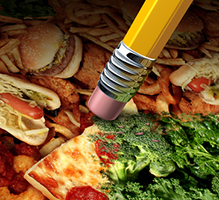 Making the decision to tackle inflammatory diseases like arthritis and type 2 diabetes isn’t a difficult one to make. The execution, however, can be difficult if you don’t know where or how to start.
Making the decision to tackle inflammatory diseases like arthritis and type 2 diabetes isn’t a difficult one to make. The execution, however, can be difficult if you don’t know where or how to start.
Couple that with the overwhelming volume of bad advice in the form of self-help fads, and it’s easy to see how people can get derailed on their paths to healthier living.
Most experts agree that to make significant lifestyle changes, it’s best to ease into it and take it slowly for lasting change. Sometimes, though, the first few baby steps can start the ball rolling on what quickly becomes sustained momentum in the anti-inflammatory lifestyle.
Diets like DASH, Mediterranean, Paleo, and the like all have one thing in common- they support an anti-inflammation effort.
Another thing they all have in common is the rejection of processed, pre-packaged foods in favor of natural, fresh, colorful options with healthy oils and Omega-3 fatty acids.
The 2 things to remember in taking the first slow steps toward anti-inflammation diets are to:
1) add foods that proactively beat back inflammation processes; and,
2) stop eating foods that cause inflammation.
These are mutually exclusive, but they don’t have to be. For example, you can start loading up on colorful vegetables at every meal, steamed to perfection, but if you are then smothering them in processed cheese goo from a box, it’s kind of a wash.
The trick is to start making little switches that don’t cause you to suffer too terribly while your body and taste buds acclimate to life without processed junk.
These key elements are the baby steps to start you on the path of better living and the end of inflammation-causing processes:
1) Rainbow plates: Start with one meal daily that involves vibrant color: Bright orange of a bell pepper, deep green of a spear of broccoli, or rich purple of eggplant…when you make the decision to start adding these to your plate every day at one, then two, then three meals and so on, you will come to crave them.
2) End beige food: bleached white flour, processed white rice, golden fried potatoes or onions…these are empty calories, first of all. Not only do they NOT contribute any anti-oxidative benefits, but they ADD free radicals that attack your body. Work at switching out white rice for quinoa or whole grain rice in recipes, and so on.
3) Oils matter more than you know: If you have corn, safflower, sunflower, or anything other than coconut, olive or flax seed oil in your cabinets, toss it. These oils are overloaded with Omega-6 fatty acids. We still need Omega-6, but not at the levels most foods provide. Coconut and olive oils are the powerhouse oils with the critical Omega-3 balance we need.
These are only 3 of the many steps that can go into ending inflammation. But you have to get started somewhere.
Have you made the decision to fully commit to an anti-inflammation lifestyle? That means overcoming type 2 diabetes, arthritis, cardiovascular diseases and most other health issues.
Or if arthritis is your pain:
Follow this step-by-step plan to eliminate arthritis pain and other symptoms in 28 days…

 Overcoming IBD
Overcoming IBD Multiple Sclerosis
Multiple Sclerosis Banishing Bronchitis
Banishing Bronchitis Gum Disease Gone
Gum Disease Gone Overcoming Onychomycosis
Overcoming Onychomycosis Neuropathy No More
Neuropathy No More The Prostate Protocol
The Prostate Protocol Brain Booster
Brain Booster
 Ironbound
Ironbound
 Solution for Shingles
Solution for Shingles
 The Bone Density Solution
The Bone Density Solution
 The Ultimate Healing Protocol
The Ultimate Healing Protocol
 The Parkinson's Protocol
The Parkinson's Protocol
 The Chronic Kidney Disease Solution
The Chronic Kidney Disease Solution
 Overthrowing Anxiety
Overthrowing Anxiety The Fatty Liver Solution
The Fatty Liver Solution The Hypothyroidism Solution
The Hypothyroidism Solution
 The End of Gout
The End of Gout The Blood Pressure Program
The Blood Pressure Program
 The Oxigized Cholesterol Strategy
The Oxigized Cholesterol Strategy
 Stop Snoring And Sleep Apnea Program
Stop Snoring And Sleep Apnea Program
 The Arthritis Strategy
The Arthritis Strategy The Vertigo & Dizziness Program
The Vertigo & Dizziness Program The 3-Step Diabetes Strategy
The 3-Step Diabetes Strategy Hemorrhoids Healing Protocol
Hemorrhoids Healing Protocol The Erectile Dysfunction Master
The Erectile Dysfunction Master Weight Loss Breeze
Weight Loss Breeze The IBS Program
The IBS Program The Insomnia Program
The Insomnia Program The Migraine and Headache Program
The Migraine and Headache Program The Neck Pain Solution
The Neck Pain Solution The Menopause Solution
The Menopause Solution The Ejaculation Master
The Ejaculation Master The TMJ Solution
The TMJ Solution The Acid Reflux Solution
The Acid Reflux Solution The Fibromyalgia Solution
The Fibromyalgia Solution The Psoriasis Strategy
The Psoriasis Strategy
The majority of Asians (that is, the majority of people in the world) have existed for milennia on a diet centered on white rice. Mediterraneans, whose diet is so well regarded, eat white rice and pasta made from white flour. The French eat lots of white bread. I find it very difficult to believe that white rice and white flour are the villains you portray them to be.